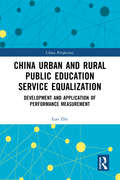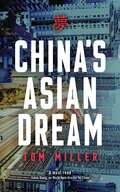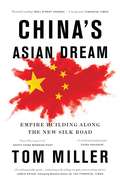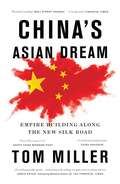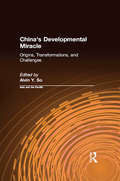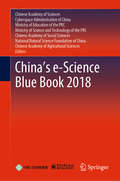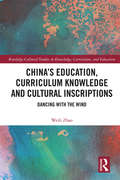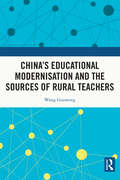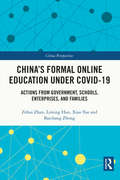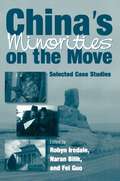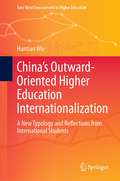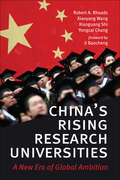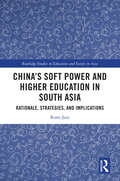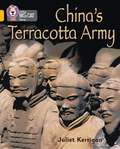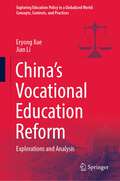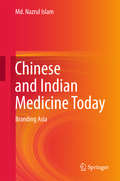- Table View
- List View
China Urban and Rural Public Education Service Equalization: Development and Application of Performance Measurement (China Perspectives)
by Luo ZheCentering on issues of disparity and equality in basic public education services in China, this book proposes a performance measurement system that assesses and guides equality of basic public education in urban and rural areas. The author moves beyond traditional research approaches by drawing on methods of public management and mathematics. Pivoted on an improved balanced scorecard model, a complete set of indicators and measuring tools are constructed, whereby the process of education equality can be more effectively measured, managed, and steered. Grounded in empirical studies on public education in the country's Sichuan Province, the book advances suggestions on better policies and optimizing implementation for the purpose of attaining equitable public education services in urban and rural areas. Finally, the study envisages further research directions and possible applications of the performance appraisal model. The title will be of value to scholars and students of education studies, especially those interested in public education, educational equity, and Chinese public education services.
China Urban and Rural Public Education Service Equalization: Development and Application of Performance Measurement (China Perspectives)
by Luo ZheCentering on issues of disparity and equality in basic public education services in China, this book proposes a performance measurement system that assesses and guides equality of basic public education in urban and rural areas. The author moves beyond traditional research approaches by drawing on methods of public management and mathematics. Pivoted on an improved balanced scorecard model, a complete set of indicators and measuring tools are constructed, whereby the process of education equality can be more effectively measured, managed, and steered. Grounded in empirical studies on public education in the country's Sichuan Province, the book advances suggestions on better policies and optimizing implementation for the purpose of attaining equitable public education services in urban and rural areas. Finally, the study envisages further research directions and possible applications of the performance appraisal model. The title will be of value to scholars and students of education studies, especially those interested in public education, educational equity, and Chinese public education services.
China's Asian Dream: Empire Building along the New Silk Road
by Tom Miller"China", Napoleon once remarked, "is a sleeping lion. Let her sleep, for when she wakes she will shake the world." In 2014, President Xi Jinping triumphantly declared the lion had awakened. Under his leadership, China is pursuing a dream to restore its historical position as the dominant power in Asia.From the Mekong River Basin to the Central Asian steppe, China is flexing its economic muscles for strategic ends. By setting up new regional financial institutions, Beijing is challenging the post-World War II order established under the watchful eye of Washington. And by funding and building roads, railways, ports and power lines-a New Silk Road across Eurasia and through the South China Sea and Indian Ocean-China aims to draw its neighbours ever tighter into its embrace.Combining a geopolitical overview with on-the-ground reportage from a dozen countries, China's Asian Dream offers a fresh perspective on the rise of China' and asks: what does it means for the future of Asia?
China's Asian Dream: Empire Building along the New Silk Road
by Tom Miller'China', Napoleon once remarked, 'is a sleeping lion. Let her sleep, for when she wakes she will shake the world.' In 2014, President Xi Jinping triumphantly declared that the lion had awoken.From holding its ground in trade wars with the US, to presenting itself as a world leader in the fight against climate change, a newly confident China is flexing its economic muscles for strategic ends. With the Belt and Road initiative, billed as a new Silk Road for the 21st Century, China is set to extend its influence throughout Eurasia and across the South China Sea and the Indian Ocean. But with the Chinese and US militaries also vying over the Pacific, does this newfound confidence put China on a collision course with the US?Combining a geopolitical overview with on-the-ground reportage from a dozen countries, this new edition of China's Asian Dream engages with the most recent developments in the ongoing story of China's ascendency, and offers new insights into what the rise of China means not only for Asia, but for the world.
China's Asian Dream: Empire Building along the New Silk Road
by Tom Miller"China", Napoleon once remarked, "is a sleeping lion. Let her sleep, for when she wakes she will shake the world." In 2014, President Xi Jinping triumphantly declared the lion had awakened. Under his leadership, China is pursuing a dream to restore its historical position as the dominant power in Asia.From the Mekong River Basin to the Central Asian steppe, China is flexing its economic muscles for strategic ends. By setting up new regional financial institutions, Beijing is challenging the post-World War II order established under the watchful eye of Washington. And by funding and building roads, railways, ports and power lines-a New Silk Road across Eurasia and through the South China Sea and Indian Ocean-China aims to draw its neighbours ever tighter into its embrace.Combining a geopolitical overview with on-the-ground reportage from a dozen countries, China's Asian Dream offers a fresh perspective on the rise of China' and asks: what does it means for the future of Asia?
China's Asian Dream: Empire Building along the New Silk Road
by Tom Miller'China', Napoleon once remarked, 'is a sleeping lion. Let her sleep, for when she wakes she will shake the world.' In 2014, President Xi Jinping triumphantly declared that the lion had awoken.From holding its ground in trade wars with the US, to presenting itself as a world leader in the fight against climate change, a newly confident China is flexing its economic muscles for strategic ends. With the Belt and Road initiative, billed as a new Silk Road for the 21st Century, China is set to extend its influence throughout Eurasia and across the South China Sea and the Indian Ocean. But with the Chinese and US militaries also vying over the Pacific, does this newfound confidence put China on a collision course with the US?Combining a geopolitical overview with on-the-ground reportage from a dozen countries, this new edition of China's Asian Dream engages with the most recent developments in the ongoing story of China's ascendency, and offers new insights into what the rise of China means not only for Asia, but for the world.
China's Developmental Miracle: Origins, Transformations, and Challenges
by Alvin Y. SoIn contrast to the failure to economic reforms in Eastern Europe, China's economic reforms have been quite successful. Decollectivization, marketization, state enterprise reforms, and reintegration into the world economy have led to very rapid economic development in China over the past two decades. These economic reforms, in turn, triggered profound social and political changes. This collection examines the origins, nature, and impact, as well as the future prospects of these reforms and changes. The contributors are all active researchers from a variety of disciplines, including economics, sociology, political science, and geography.
China's Developmental Miracle: Origins, Transformations, and Challenges
by Alvin Y. SoIn contrast to the failure to economic reforms in Eastern Europe, China's economic reforms have been quite successful. Decollectivization, marketization, state enterprise reforms, and reintegration into the world economy have led to very rapid economic development in China over the past two decades. These economic reforms, in turn, triggered profound social and political changes. This collection examines the origins, nature, and impact, as well as the future prospects of these reforms and changes. The contributors are all active researchers from a variety of disciplines, including economics, sociology, political science, and geography.
China’s e-Science Blue Book 2018
by Chinese Academy of Sciences Cyberspace Administration of China Ministry of Education of the PRC Ministry of Science Technology of the PRC Chinese Academy of Social Sciences National Natural Science Foundation of China Chinese Academy of Agricultural SciencesThis book is jointly compiled by Chinese Academy of Sciences, Cyberspace Administration of China, Ministry of Education of the People’s Republic of China, Ministry of Science and Technology of the People’s Republic of China, Chinese Academy of Social Sciences, National Natural Science Foundation of China and Chinese Academy of Agricultural Sciences. Over the past several years, Chinese scholars have contributed numerous research works on the development of Chinese scientific information and technology, and produced a range of outstanding achievements. Focusing on the main topic of e-Science, this book explores the forefront of science and technology around the globe, the major demands in China and the main fields in China’s economic development. Furthermore, it reviews the major achievements and the typical cases in China's e-Science research. It provides a valuable reference source for future technological innovations and will introduce researchers and students in the area of e-Science to the latest results in China.
China’s Education, Curriculum Knowledge and Cultural Inscriptions: Dancing with The Wind (Routledge Cultural Studies in Knowledge, Curriculum, and Education)
by Weili ZhaoWith a focus on the role of discourse and language in education, this book examines China’s educational reform from an original perspective that avoids mapping on Westernized educational sensibilities to a Chinese environment. Zhao untangles the tradition-modernity division expressed in China’s educational language about the body and teacher-student difference. Exploring the historical and cultural implications of the ways China’s schooling is talked about and acted upon, Zhao argues that Chinese notion "wind" (feng) is a defining aspect of Chinese teaching and learning. Incorporating Western and Chinese literature, this book explores the language of education, curriculum, and knowledge on a cross-cultural landscape and as cultural inscriptions.
China’s Education, Curriculum Knowledge and Cultural Inscriptions: Dancing with The Wind (Routledge Cultural Studies in Knowledge, Curriculum, and Education)
by Weili ZhaoWith a focus on the role of discourse and language in education, this book examines China’s educational reform from an original perspective that avoids mapping on Westernized educational sensibilities to a Chinese environment. Zhao untangles the tradition-modernity division expressed in China’s educational language about the body and teacher-student difference. Exploring the historical and cultural implications of the ways China’s schooling is talked about and acted upon, Zhao argues that Chinese notion "wind" (feng) is a defining aspect of Chinese teaching and learning. Incorporating Western and Chinese literature, this book explores the language of education, curriculum, and knowledge on a cross-cultural landscape and as cultural inscriptions.
China's Educational Modernisation and the Sources of Rural Teachers
by Wang GuomingDrawing on modernisation theory, this book charts the history and development of China’s rural education while examining the changes in rural teacher training and recruitment since the beginning of the 20th century.Highlighting the changes in the composition of the body of rural teachers after modern schools were established in rural areas in China, the author outlines and discusses several historical phases that figure in the transformation of the teaching profession, including traditional private homeschooling teachers (sishu teachers), the earliest group of teachers of new-style schools, non-government teachers, teachers trained in normal schools and substitute teachers. Based on field studies in a county in northern China, the book analyses various contributing factors in rural teacher resourcing, ranging from China’s modernisation and urbanisation, the county’s social and economic development, management systems of rural schools and teachers, and teacher training and recruiting mechanisms. It also introduces the temporary solutions and long-term plans that have been adopted and implemented in different historical periods to regenerate the rural teaching force.The title will be a useful reference for scholars, students, and policymakers interested in modern and contemporary education in China, rural teachers, and rural education.
China's Educational Modernisation and the Sources of Rural Teachers
by Wang GuomingDrawing on modernisation theory, this book charts the history and development of China’s rural education while examining the changes in rural teacher training and recruitment since the beginning of the 20th century.Highlighting the changes in the composition of the body of rural teachers after modern schools were established in rural areas in China, the author outlines and discusses several historical phases that figure in the transformation of the teaching profession, including traditional private homeschooling teachers (sishu teachers), the earliest group of teachers of new-style schools, non-government teachers, teachers trained in normal schools and substitute teachers. Based on field studies in a county in northern China, the book analyses various contributing factors in rural teacher resourcing, ranging from China’s modernisation and urbanisation, the county’s social and economic development, management systems of rural schools and teachers, and teacher training and recruiting mechanisms. It also introduces the temporary solutions and long-term plans that have been adopted and implemented in different historical periods to regenerate the rural teaching force.The title will be a useful reference for scholars, students, and policymakers interested in modern and contemporary education in China, rural teachers, and rural education.
China's Formal Online Education under COVID-19: Actions from Government, Schools, Enterprises, and Families (China Perspectives)
by Zehui Zhan Liming Huo Xiao Yao Baichang ZhongThis book investigates how schools, enterprises and families in China have coped with the formal online education in the light of government policy throughout the COVID-19 epidemic outbreak, with special focus on the problems they have encountered and possible solutions. Using grounded theory, over 1000 posts retrieved from public online forums were analyzed under a 4*4 framework, referring to four special time nodes (proposal period, exploratory period, full deployed period, exiting period) and four major subjects (government, schools, enterprises, families). The book identifies four main issues faced by massive online education during the epidemic: platform selection in proposal period, teacher training in exploratory period, resource integration in full deployed period, and flexibility of returning to schools in exiting period. These findings enlighten us with a deeper understanding of the process of online learning in an educational emergency, helping to develop best countermeasures in similar situations, as well as to provide paths to follow for other countries. The book will appeal to teachers, researchers and school administrators of the online education and education emergency management, as well as those who are interested in Chinese education during the COVID-19 outbreak in general.
China's Formal Online Education under COVID-19: Actions from Government, Schools, Enterprises, and Families (China Perspectives)
by Zehui Zhan Liming Huo Xiao Yao Baichang ZhongThis book investigates how schools, enterprises and families in China have coped with the formal online education in the light of government policy throughout the COVID-19 epidemic outbreak, with special focus on the problems they have encountered and possible solutions. Using grounded theory, over 1000 posts retrieved from public online forums were analyzed under a 4*4 framework, referring to four special time nodes (proposal period, exploratory period, full deployed period, exiting period) and four major subjects (government, schools, enterprises, families). The book identifies four main issues faced by massive online education during the epidemic: platform selection in proposal period, teacher training in exploratory period, resource integration in full deployed period, and flexibility of returning to schools in exiting period. These findings enlighten us with a deeper understanding of the process of online learning in an educational emergency, helping to develop best countermeasures in similar situations, as well as to provide paths to follow for other countries. The book will appeal to teachers, researchers and school administrators of the online education and education emergency management, as well as those who are interested in Chinese education during the COVID-19 outbreak in general.
China's Minorities on the Move: Selected Case Studies
by Robyn Iredale Naran Bilik Guo FeiThe movement of Han Chinese into minority regions has been a long-standing pattern in China. However, China's minorities have taken longer to start moving in significant numbers and have now become part of a social change phenomenon, motivated by economic, social, and political factors. This book looks at how current changes in China are affecting the minority population. The case studies focus on how population shifts and the movement of China's minorities impact such issues as education, ethnic identity, the environment, local economy, labor, and regional development. Han-minority interactions within a number of regions are also examined.
China's Minorities on the Move: Selected Case Studies
by Robyn Iredale Naran Bilik Guo FeiThe movement of Han Chinese into minority regions has been a long-standing pattern in China. However, China's minorities have taken longer to start moving in significant numbers and have now become part of a social change phenomenon, motivated by economic, social, and political factors. This book looks at how current changes in China are affecting the minority population. The case studies focus on how population shifts and the movement of China's minorities impact such issues as education, ethnic identity, the environment, local economy, labor, and regional development. Han-minority interactions within a number of regions are also examined.
China’s Outward-Oriented Higher Education Internationalization: A New Typology and Reflections from International Students (East-West Crosscurrents in Higher Education)
by Hantian WuThis book introduces a new typology of “inward- and outward-oriented” higher education internationalization, and investigates China’s current situation of shifting from a mainly “inward-oriented” higher education internationalization to a more balanced approach. It describes the gap between China’s soft power goals of using higher education internationalization for image and influence enhancement and the reality, and examines the three major dimensions of China’s “outward-oriented” higher education internationalization (i.e. the Confucius Institute program based on Sino-foreign higher education collaboration, international development aid in higher education, and higher education level international student recruitment) based on reflections provided by international graduate students in English instruction programs in education-related majors in three Chinese universities. Providing both theoretical insights and real-world examples, this book is suitable for higher education researchers, graduate students in the relevant fields, administrators of higher education institutions, and policymakers in the government sector.
China's Rising Research Universities: A New Era of Global Ambition
by Robert A. Rhoads Xiaoyang Wang Xiaoguang Shi Yongcai ChangThis timely study charts the intentional and accelerated rise of China’s research universities by analyzing how state policy has transformed key institutions. Specifically, it addresses how state initiatives have influenced faculty life and academic culture at these campuses. Based on empirical studies at four of the nation’s leading universities and including more than seventy semi-structured interviews with professors and key administrators, China's Rising Research Universities sheds light on fundamental changes in faculty life. These changes amount to nothing short of a dramatic transformation of academic culture at the nation’s top universities. National initiatives driven by China’s Ministry of Education seek to develop two overlapping sets of leading universities, through what are known as Project 211 (which affects about 100 universities) and Project 985 (which affects about 40 universities). Project 985 enhancements are particularly important to the country’s efforts to strengthen university science and research. The book also addresses the broader context of higher education reform in China, arguing that recent efforts to elevate the nation’s top universities toward world-class standing represent a shift in higher education policy development and implementation leading to what is described as China’s Global Ambition Period. Offering important insights into the changing higher education policy context in an age increasingly defined by globalization, China's Rising Research Universities will appeal to higher education leaders and policymakers; students, faculty, and scientists who interact with Chinese counterparts; and scholars of international and comparative studies.
China's Rising Research Universities: A New Era of Global Ambition
by Robert A. Rhoads Xiaoyang Wang Xiaoguang Shi Yongcai ChangThis timely study charts the intentional and accelerated rise of China’s research universities by analyzing how state policy has transformed key institutions. Specifically, it addresses how state initiatives have influenced faculty life and academic culture at these campuses. Based on empirical studies at four of the nation’s leading universities and including more than seventy semi-structured interviews with professors and key administrators, China's Rising Research Universities sheds light on fundamental changes in faculty life. These changes amount to nothing short of a dramatic transformation of academic culture at the nation’s top universities. National initiatives driven by China’s Ministry of Education seek to develop two overlapping sets of leading universities, through what are known as Project 211 (which affects about 100 universities) and Project 985 (which affects about 40 universities). Project 985 enhancements are particularly important to the country’s efforts to strengthen university science and research. The book also addresses the broader context of higher education reform in China, arguing that recent efforts to elevate the nation’s top universities toward world-class standing represent a shift in higher education policy development and implementation leading to what is described as China’s Global Ambition Period. Offering important insights into the changing higher education policy context in an age increasingly defined by globalization, China's Rising Research Universities will appeal to higher education leaders and policymakers; students, faculty, and scientists who interact with Chinese counterparts; and scholars of international and comparative studies.
China’s Soft Power and Higher Education in South Asia: Rationale, Strategies, and Implications (Routledge Studies in Education and Society in Asia)
by Romi JainThis empirical work illuminates how China uses the higher education mechanism in South Asia to advance its national interests and investigates the outcomes for China, including both challenges and opportunities. Using a soft power theoretical framework, this book employs the case study of Nepal, a South Asian country of profound geostrategic value for the two competing powers of China and India. Illustrating how higher education is the mechanism for achieving soft power goals, it draws on data analysis based on archival sources and interviews with China and South Asia experts, including academics and politico-bureaucratic elites, as well as interviews with Nepalese students and alumni. Importantly though, this book advances an innovative conceptual model of geointellect to trace the evolving dimensions of China’s global dominance in higher education, research, and innovation paradigm, especially in the context of the Belt and Road Initiative and ultimately reveals how foreign policy and higher education policy reinforce each other in the context of China. China’s Soft Power and Higher Education in South Asia provides an empirically rich resource for students and scholars of education, international relations, Asian studies, and China’s soft power.
China’s Soft Power and Higher Education in South Asia: Rationale, Strategies, and Implications (Routledge Studies in Education and Society in Asia)
by Romi JainThis empirical work illuminates how China uses the higher education mechanism in South Asia to advance its national interests and investigates the outcomes for China, including both challenges and opportunities. Using a soft power theoretical framework, this book employs the case study of Nepal, a South Asian country of profound geostrategic value for the two competing powers of China and India. Illustrating how higher education is the mechanism for achieving soft power goals, it draws on data analysis based on archival sources and interviews with China and South Asia experts, including academics and politico-bureaucratic elites, as well as interviews with Nepalese students and alumni. Importantly though, this book advances an innovative conceptual model of geointellect to trace the evolving dimensions of China’s global dominance in higher education, research, and innovation paradigm, especially in the context of the Belt and Road Initiative and ultimately reveals how foreign policy and higher education policy reinforce each other in the context of China. China’s Soft Power and Higher Education in South Asia provides an empirically rich resource for students and scholars of education, international relations, Asian studies, and China’s soft power.
China's Terracotta Army (Collins Big Cat Ser.)
by Juliet Kerrigan Collins StaffWhen the First Emperor of China died 2,000 years ago, he was buried in a giant tomb. In 1974, this tomb was discovered along with an army of over 6,000 terracotta warriors. Discover the army for yourself and the reason they were buried with the Emperor.
China’s Vocational Education Reform: Explorations and Analysis (Exploring Education Policy in a Globalized World: Concepts, Contexts, and Practices)
by Eryong Xue Jian LiThis book explores the holistic development of vocational education in Chinese education system. It investigates the vocational education policy development, student development, allocation of teachers’ resources, financial mechanism and system, students’ financial aid, examination and enrollment, private vocational education system, and school-enterprise cooperation. In addition, this book critically examines and epitomizes the contextualized China’s vocational education reform from multiple dimensions. This book also offers an in-depth explorations and analysis of current Chinese vocational education reform comprehensively. This is a highly informative and carefully presented book, providing academic insight for scholars and researchers who are interested and work in research on China’s vocational education reform in China as well as the administrators and stakeholders in Chinese education system and graduate students who majoring in the field of educational policy.
Chinese and Indian Medicine Today: Branding Asia
by Md. Nazrul IslamThis book discusses Asian medicine, which puts enormous emphasis on prevention and preservation of health, and examines how, in recent decades, medical schools in Asia have been increasingly shifting toward a curative approach. It offers an ethnographic investigation of the scenarios in China and India and finds that modern students and graduates in these countries perceive Asian medicine to be as important as Western medicine. There is a growing tendency to integrate Asian medicine with Western medical thought in the academic curriculum that has led to a gradual decline of Asian medical thought and practices. At the same time, there has been a massive rise in patent drugs, health products and cosmetics being sold under the brand names of Asian medicine or herbal medicine. Most of these drugs and health products do not follow the classical formulas found in the Asian medical texts. The book analyses these texts and concludes that contemporary Asian medicine rarely follows the classical texts, and in fact uses Asian medicine brands to sell Western health products and practices.With a particular focus on the formal and professional sector of Chinese herbal medicine and Indian ayurvedic medicine in urban areas, this book appeals to a broad readership, including undergraduate students and academics as well as non-experts.Md. Nazrul Islam is an Associate Professor in the General Education Office, United International College, Beijing Normal University-Hong Kong Baptist University. He was a Visiting Associate Professor in the School of Population and Public Health, University of British Columbia (2015-16) during which time he completed this book manuscript.
